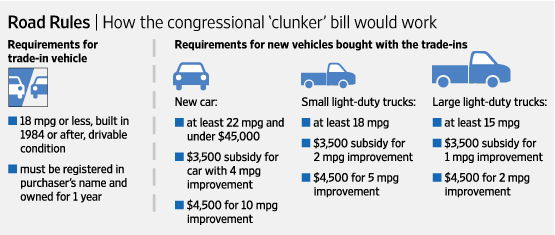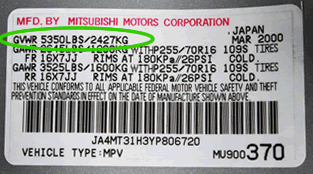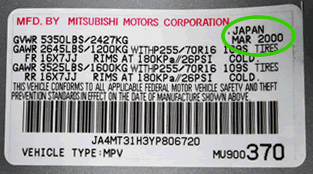Recently, the U.S. Government passed legislation providing vouchers valued from $3,500 to $4,500 when you trade-in a vehicle and purchase a new one that meets or exceeds higher MPG standards. The Car Allowance Rebate System (or CARS — commonly referred to as Cash for Clunkers or Customer Assistance to Recycle and Save) is available to customers at registered, participating dealers.
The CAR Allowance Rebate System (CARS) is a $1 billion government program that helps consumers buy or lease a more environmentally-friendly vehicle from a participating dealer when they trade in a less fuel-efficient car or truck. The program is designed to energize the economy; boost auto sales and put safer, cleaner and more fuel-efficient vehicles on the nation’s roadways.
Consumers will be able to take advantage of this program and receive a $3,500 or $4,500 discount from the car dealer when they trade in their old vehicle and purchase or lease a new one. Consumers you do not need to register anywhere or at anytime for this program. However, to find out eligibility requirements click here.

• Your vehicle must be less than 25 years old on the trade-in date
• Only purchase or lease of new vehicles qualify
• Generally, trade-in vehicles must get 18 or less MPG (some very large pick-up trucks and cargo vans have different requirements)
• Trade-in vehicles must be registered and insured continuously for the full year preceding the trade-in
• You don’t need a voucher, dealers will apply a credit at purchase
• Program runs through Nov 1, 2009 or when the funds are exhausted, whichever comes first.
• The program requires the scrapping of your eligible trade-in vehicle, and that the dealer disclose to you an estimate of the scrap value of your trade-in. The scrap value, however minimal, will be in addition to the rebate, and not in place of the rebate.
Does your trade-in qualify?
Your trade-in is:
A car, pickup truck, van, or SUV with a Gross Vehicle Weight Rating (GVWR) of 8,500 lbs. or less
A truck, van, or SUV with a GVWR greater than 8,500 lbs. and less than 10,000 lbs. Click here for examples.
What is Gross Vehicle Weight Rating (GVWR)?

GVWR is the maximum allowable total weight of a vehicle when loaded, including the vehicle itself plus fuel, passengers, cargo, and trailer tongue weight. This is a fixed weight specified by the manufacturer.
You can typically find your vehicle’s GVWR (1) on the standard certification label that appears on the frame or edge of the driver’s door in most vehicles or (2) in your vehicle’s owner’s manual.
Does your trade-in qualify?
Your Trade-in Vehicle Year Must Be Between 1984 to 2010.
Note: Trade-in vehicles must have been manufactured within the last 25 years. Some 1984 model year vehicles will not meet this requirement. For these vehicles, please check the manufacture date. Model year 1984 vehicles manufactured in the same month or later in the year than the month you trade your vehicle meet the 25-year requirement.

How do I find my manufacture date?
The month and year during which your vehicle was manufactured can be found on the safety standard certification label that appears on the frame or edge of the driver’s door in most vehicles.
Does your trade-in qualify?
Here’s a list of car Makes and Models that may qualify. Be sure to check the government website to make sure your particular car is on the list.
Alfa Romeo, AM General, American Motors Corporation, Aston Martin, Audi, Avanti Motor Corporation, Bertone, Bill Dovell Motor Car Company, Bitter Gmbl and Co. Kg, BMW, Buick, Cadillac, Chevrolet, Chrysler, Dodge, Ford, GMC, Grumman Olson, Honda, Import Foreign Auto Sales Inc, Isuzu, Jaguar, Jeep, Kenyon Corporation Of America, Lamborghini, Lincoln, Lotus, Maserati, Mazda, Mercedes-Benz, Mercury, Mitsubishi, Nissan, Oldsmobile, Peugeot, Pininfarina, Plymouth, Pontiac, Porsche, Renault, Rolls-Royce, S and S Coach Company E.p. Dutton, Saab, Subaru, Superior Coaches Div E.p. Dutton, Suzuki, Toyota, Volkswagen, Volvo
Source:
Cash-for-Clunkers Clears Hurdle
JOSH MITCHELL and COREY BOLES
WSJ, JUNE 13, 2009
http://online.wsj.com/article/SB124485495153311725.html
Source:
Leave a Reply